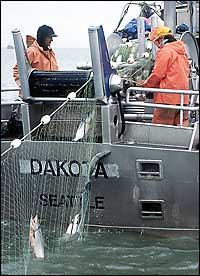forum
library
tutorial
contact

Climate Shifts Tied to Salmon Population
by Jeff Barnard of the Associated PressSeattle Times - April 18, 2002
|
the film forum library tutorial contact |

|
Climate Shifts Tied to Salmon Populationby Jeff Barnard of the Associated PressSeattle Times - April 18, 2002 |
 Thousands of years before dams or commercial fishing boats, Pacific salmon experienced huge population swings that coincided with major climate shifts, scientists report.
Thousands of years before dams or commercial fishing boats, Pacific salmon experienced huge population swings that coincided with major climate shifts, scientists report.
Researchers say the findings — based on sediment core samples pulled from the bottom of an Alaska lake — suggest that fisheries managers should consider global warming's potential influence as they plan their catches over the long term.
"This is clear evidence we have to rethink our ideas about how we would manage salmon," said Dick Beamish, senior scientist with Fisheries and Oceans Canada in Nanaimo, B.C., who did not contribute to the study. "Whether you believe in global warming or not, we've got to realize that what we are putting up in the atmosphere can affect salmon."
U.S. and Canadian researchers drove a pipe through the bottom of Karluk Lake on Kodiak Island. They withdrew samples of the silt that formed over the centuries in layers. They looked for tiny algae known as diatoms and the isotope nitrogen 15, which were left behind by salmon after they spawned.
Concentrations of these biological markers change every year in direct proportion to how many salmon return to spawn, said the study's lead author, University of Alaska Fairbanks paleoceanographer Bruce Finney.
They estimated Karluk Lake sockeye populations ranged from about 3 million to 100,000 during the past 2,200 years.
They determined that salmon populations were relatively high 2,200 years ago, but crashed around 100 B.C., and remained low until they rapidly increased around A.D. 1200. They remained high until commercial fishing drove numbers down around 1900.
The findings were published in today's issue of the journal Nature.
Finney said the population swings coincided with major global climate changes that were well-known in the historical record, as well as changes in other fish populations elsewhere. The A.D. 1200 salmon boom, for example, came at the end of a period known as the Medieval Warming.
"Salmon came on like gangbusters in Alaska and anchovies and sardines crashed in southern California," Finney said.
Global average temperatures have increased by more than 1 degree Fahrenheit in the past several decades, coinciding with the accumulation of carbon dioxide and other pollutants in the atmosphere. Computer models project temperatures could rise more than 10 degrees by the end of the 21st century with potentially catastrophic environmental results.
Many scientists acknowledge that the climate projections rely on incomplete information, and the Earth has experienced large climate shifts before. But the projected warming is driven by human activities, they explain.
Since 1996, scientists have been extending their understanding of a phenomenon known as the Pacific Decadal Oscillation, an El Niño-like condition that affects water temperatures. The PDO seems to flip-flop every 20 to 30 years. In the current cool phase, it produces lots of food for salmon off the West Coast, and starvation conditions off Alaska. When it flips to the warm phase, conditions shift.
Last year's jump in returns of salmon to the Columbia River were attributed in part to the beginning of a new cool cycle.
Peter Dygert, chief of sustainable fisheries for the National Marine Fisheries Service in Seattle, said fisheries managers are aware of global climate cycles such as El Niño as factors in salmon abundance. However, he said global-climate models are not accurate enough to offer much help in managing salmon harvests.
learn more on topics covered in the film
see the video
read the script
learn the songs
discussion forum
